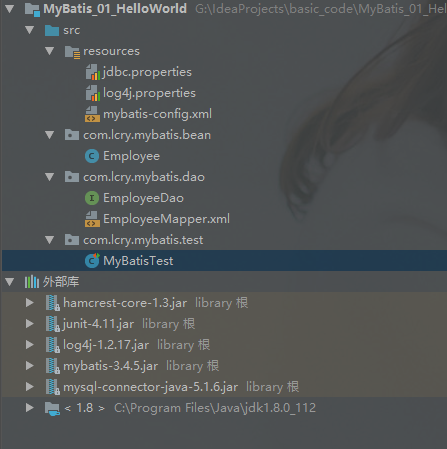Mybatis从入门到精通(一)
MyBatis 是一款优秀的持久层框架,它支持定制化 SQL、存储过程以及高级映射。MyBatis 避免了几乎所有的 JDBC 代码和手动设置参数以及获取结果集。MyBatis 可以使用简单的 XML 或注解来配置和映射原生信息,将接口和 Java 的 POJOs(Plain Old Java Objects,普通的 Java对象)映射成数据库中的记录,自由灵活生成(半自动化,大部分需要程序员编写sql)。
Mybatis官方文档:http://www.mybatis.org/mybatis-3/zh/index.html
一、框架原理:
mybatisconfig.xml:(是mybatis的全局配置文件,名称不固定的)配置了数据源、事务等mybatis运行环境
mapper.xml:配置sql语句
SqlSessionFactory:(会话工厂),根据配置文件创建工厂作用:创建SqlSession
SqlSession:(会话),是一个接口,面向用户(程序员)的接口作用:操作数据库(发出sql增、删、改、查)
Executor:(执行器),是一个接口(基本执行器、缓存执行器)作用:SqlSession内部通过执行器操作数据库
mapped statement:(底层封装对象)作用:对操作数据库存储封装,包括 sql语句,输入参数、输出结果类型。
二、开始使用
1)环境:
jdk1.8,mysql5.6,IDEA,必要jar包
若使用maven可使用下面AVG导入(当前选择版本3.4.5):
<dependency>
<groupId>org.mybatis</groupId>
<artifactId>mybatis</artifactId>
<version>3.4.5</version>
</dependency>2)创建必要配置文件:
log4j.properties(log4j日志配置文件):
#初始化定义日志级别
log4j.rootLogger=DEBUG,Console
#输出到控制台
log4j.appender.Console=org.apache.log4j.ConsoleAppender
log4j.appender.Console.layout=org.apache.log4j.PatternLayout
log4j.appender.Console.layout.ConversionPattern=%d [%t] %-5p [%c] - %m%n
log4j.logger.org.apache=INFOmybatis-config.xml(mybatis配置文件):
<?xml version="1.0" encoding="UTF-8" ?>
<!DOCTYPE configuration
PUBLIC "-//mybatis.org//DTD Config 3.0//EN"
"http://mybatis.org/dtd/mybatis-3-config.dtd">
<configuration>
<properties resource="jdbc.properties" />
<settings>
<!--设置自动驼峰命名转换-->
<setting name="mapUnderscoreToCamelCase" value="true"/>
</settings>
<!-- 和spring整合后 environments配置将废除 -->
<environments default="development">
<environment id="development">
<transactionManager type="JDBC"/>
<dataSource type="POOLED">
<property name="driver" value="${driver}"/>
<property name="url" value="${url}"/>
<property name="username" value="${username}"/>
<property name="password" value="${password}"/>
</dataSource>
</environment>
</environments>
<mappers>
<!--加载映射文件-->
<mapper resource="com/lcry/mybatis/dao/EmployeeMapper.xml"/>
</mappers>
</configuration>jdbc.properties(数据库信息配置):
driver=com.mysql.jdbc.Driver
url=jdbc:mysql://localhost:3306/mybatis?useUnicode=true&characterEncoding=utf-8
username=root
password=123456Employee.java(实体类):
package com.lcry.mybatis.bean;
public class Employee {
private Integer id ;
private String lastname; //此处有坑
private String email;
private String gander; //此处有坑
public Integer getid() {
return id;
}
public void setId(Integer id) {
this.id = id;
}
public String getLastname() {
return lastname;
}
public void setLastname(String lastname) {
this.lastname = lastname;
}
public String getEmail() {
return email;
}
public void setEmail(String email) {
this.email = email;
}
public String getGander() {
return gander;
}
public void setGander(String gander) {
this.gander = gander;
}
@Override
public String toString() {
return "Employee{" +
"id=" + id +
", lastname='" + lastname + '\'' +
", email='" + email + '\'' +
", gander='" + gander + '\'' +
'}';
}
}
EmployeeDao.java(接口):
package com.lcry.mybatis.dao;
import com.lcry.mybatis.bean.Employee;
public interface EmployeeDao {
Employee getEmp(Integer id);
void insertemp(Employee employee);
boolean updateemp(Employee employee);
Integer deleteemp(Integer id);
}
EmployeeMapper.xml(映射文件配置):
<?xml version="1.0" encoding="UTF-8" ?>
<!DOCTYPE mapper
PUBLIC "-//mybatis.org//DTD Mapper 3.0//EN"
"http://mybatis.org/dtd/mybatis-3-mapper.dtd">
<!--命名空间,可自定义,若绑定接口,必须和接口名保持一致-->
<!--id为唯一标示-->
<mapper namespace="com.lcry.mybatis.dao.EmployeeDao">
<select id="getEmp" resultType="com.lcry.mybatis.bean.Employee">
select * from tbl_employee where id = #{id}
</select>
<insert id="insertemp" useGeneratedKeys="true" keyProperty="id">
insert into tbl_employee VALUES(null,#{lastname},#{gander},#{email})
</insert>
<update id="updateemp">
/*此处解决坑last_name*/
update tbl_employee set last_name = #{lastname} ,gender=#{gander},email=#{email} where id=#{id}
</update>
<delete id="deleteemp">
DELETE FROM tbl_employee WHERE id =#{id}
</delete>
</mapper>3)开始测试
MyBatisTest.java(测试方法):
package com.lcry.mybatis.test;
import com.lcry.mybatis.bean.Employee;
import com.lcry.mybatis.dao.EmployeeDao;
import org.apache.ibatis.io.Resources;
import org.apache.ibatis.session.SqlSession;
import org.apache.ibatis.session.SqlSessionFactory;
import org.apache.ibatis.session.SqlSessionFactoryBuilder;
import org.junit.Test;
import java.io.IOException;
import java.io.InputStream;
public class MyBatisTest {
//获取配置,创建sqlSessionFactory工厂
public static SqlSessionFactory getsqlsession() throws IOException {
String resource = "mybatis-config.xml";
InputStream inputStream = Resources.getResourceAsStream(resource);
SqlSessionFactory sqlSessionFactory = new SqlSessionFactoryBuilder().build(inputStream);
return sqlSessionFactory;
}
@Test
public void test01() throws IOException {
SqlSession sqlSession = getsqlsession().openSession();
try {
//查询方法
Employee employee = sqlSession.selectOne("com.lcry.mybatis.dao.EmployeeDao.getEmp", 10);
System.out.println(employee);
} finally {
sqlSession.close();
}
}
@Test
public void test02() throws IOException {
SqlSession sqlSession = getsqlsession().openSession(true);
try {
EmployeeDao employee = sqlSession.getMapper(EmployeeDao.class);
//查询方法
Employee emp = employee.getEmp(10);
System.out.println(emp.getid());
//插入方法
Employee employee1 = new Employee();
employee1.setLastname("lcry");
employee1.setEmail("1@qq.com");
employee1.setGander("1");
employee.insertemp(employee1);
System.out.println(employee1.toString());
//更新方法
boolean b = employee.updateemp(employee1);
System.out.println(b + employee1.toString());
//删除方法
Integer rows = employee.deleteemp(13);
System.out.println(rows);
} finally {
sqlSession.close();
}
}
}
补一份数据库sql文件(tbl_employee.sql):
SET FOREIGN_KEY_CHECKS=0;
-- ----------------------------
-- Table structure for tbl_employee
-- ----------------------------
DROP TABLE IF EXISTS `tbl_employee`;
CREATE TABLE `tbl_employee` (
`id` int(11) NOT NULL AUTO_INCREMENT,
`last_name` varchar(255) DEFAULT NULL,
`gender` char(1) DEFAULT NULL,
`email` varchar(255) DEFAULT NULL,
PRIMARY KEY (`id`)
) ENGINE=MyISAM AUTO_INCREMENT=15 DEFAULT CHARSET=utf8;
-- ----------------------------
-- Records of tbl_employee
-- ----------------------------
INSERT INTO `tbl_employee` VALUES ('10', 'lcry', '1', '1@qq.com');
INSERT INTO `tbl_employee` VALUES ('11', 'lcry', '1', '1@qq.com');
INSERT INTO `tbl_employee` VALUES ('12', 'lcry', '1', '1@qq.com');
INSERT INTO `tbl_employee` VALUES ('14', 'lcry', '1', '1@qq.com');
以上就完成了简单的增删查改,赶紧去试试吧~~
商业转载请联系作者获得授权,非商业转载请注明本文出处及文章链接
